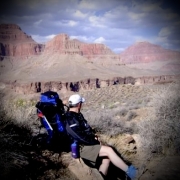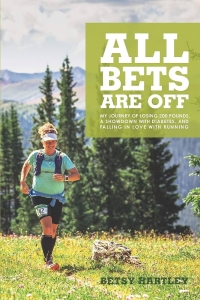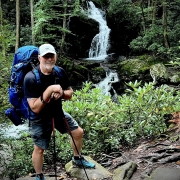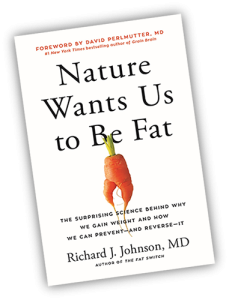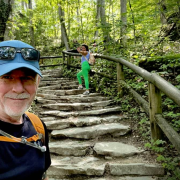What’s the Hardest Thing You’ve Done? | Healthy Aging Series: Season 9, Episode 7
What’s the Hardest Thing You’ve Done?
Seven days. Six nights. 17000+/- ft. of elevation. 41 miles. 45 lbs. Minus 2 toenails. One of the hardest things I’ve done. The Grand Canyon.
I wanted to test myself. What a better place to do that than the Grand Canyon. It was 2009. I was 52 years old, and I’d been backpacking for four years and had gone down and come out of the Canyon four times.
Nothing is easy about doing the canyon. If you think hiking down into the Grand Canyon is easy, you’d would be wrong. Think about walking down stairs for 8 to 10 miles. With 45 lbs. on your back.
You have to prepare by putting on a backpack and putting in the mileage with 30-40 lbs. in that pack.
The Canyon is one of my favorite places on the earth. I love walking up to the edge of the South Rim at Grand Canyon Village, after being away for a year, and feeling overwhelmed by the view. You can see nearly 20 miles from the South Rim to the North Rim, almost forever. It’s most beautiful when it’s just snowed and it’s cloudy. Especially in January and February when the clouds are hanging around.
I planned a 7 day, 6 night solo backpacking trip. All by myself.
Day One: 5-mile hike down to Havasu Campground and the loss of 3000 feet.
On one of my trips to the Canyon one of the regulars that I backpack with had invited a friend to “do the canyon.” This was the year my son was graduating from high school, and he was invited. They were 15 of us. A ritual was to weigh our packs at Babbage’s, the outfitting store. My pack weighed 42 pounds and my son’s was 30 pounds. We had both trained hard for this trip.
The new invitee was 50+ years old and had just quit smoking the year before and was celebrating it with the backpacking trip into the Grand Canyon. Her pack weighed 45 pounds. I glanced at my son, and we both had that, “She’s not gonna make it,“ look. And in fact, she arrived at Havasu Garden Campground without a pack. She said her legs had turned to rubber. She had dropped her pack halfway down. The next day she and her husband chose to hike out and hired a teenager to haul her pack back up to the South Rim. The Canyon is unforgiving.
I arrived at Havasu Garden CG on this trip in 3 hours, set up my camp, and slept well.
Day Two: Eleven miles on the Tonto West trail to Monument Creek CG.
This is a long 11-mile hike because you were hiking in an out of side canyons. Easily a six- or seven-hour hike. Total exposure to the sun. Day two ends at Monument Creek Campground, which is the payoff for the long hike. The bathroom is three wooden walls. No ceiling. One beautiful view.
Day Three: Nine miles. 4000 feet of elevation gain on the Hermit’s Rest Trail.
It was grueling. Remember my pack was 40+ pounds.
I had planned to hike back 11 miles to Havasu Garden Campground but changed my mind and decided to hike out the Hermit’s Rest Trail back to the South Rim. The problem was that I was going to have to walk 10 miles back to the trailhead and to my car. When I arrived at the rim, I was absolutely, exhausted. Remember I had hiked 25 miles in the past three days. I was lucky to meet a man who agreed to take me back to the trailhead but made me agree to listen to his story about going through a divorce, and how he was traveling from city to city in an RV looking for a new city to live in and call home. You can’t make something like this up. So, I listened. I stayed at the Bright Angel Lodge, took a shower, and slept in a bed.
Day Four: I hiked down the Kaibab Trail to Phantom Ranch.
8 miles. 5200 feet of elevation loss. The good news: I was fresh and rested. The bad news: I was wearing new boots that rubbed the top of my toenails and remember it was 8 miles of descent, and it resulted in blisters under my toenails. That’s right blisters, not on my toes, but under my toenails
I set up my camp at Bright Angel Campground at the bottom of the Canyon and went to bed.
Day Five and Six: My plan was to hike out to Ribbon Falls (13 miles round trip)
Instead, I popped the blisters under my toenails and laid around for two days.
The thing about the Canyon is, if you go down into the Canyon, you have to get yourself up out of the Canyon. There are mules. There are helicopters. But unless you’re almost dying, you have to get yourself out. So, I cut the toes out of my new boots and hiked 8 miles and 5200 feet up out of the Canyon.
Seven days. Six nights. 17000+/- ft. 41 miles. 45 lbs. Minus 2 toenails. One of the hardest things I’ve done.
“All Bets Are Off”
Betsy Hartley‘s book, “All Bets Are Off,” has a grueling story in it. Don’t let me confuse you here. She ran a 100-mile race in under 30 hours. I didn’t do that.
I’ve done a couple marathons. And all the training to prepare for them, but not 100 miles.
I was exhausted after reading about this race. Geez! It was one of the most grueling accounts of a race that I’ve ever read. But this is not the real story of her book.
Her story is about losing 220 pounds. Not an easy feat.
Her plan: Eat less, move more.
She started this plan in July 2011. Five years later, 220 lbs. lighter.
That was the most grueling thing she did. Imagine. Five years. 44 pounds per year. Then run 100 miles in 30 hours.
Honestly, one of the most impressive things I’ve heard or seen was she broke up with food and stayed broke up. That’s what this season of Healthy Aging is about. How to break up with food… How to change your relationship with food.
What was the turning point in her life? What were her agents of change?
What Didn’t Help?
Hartley spent 40 years of her life living with obesity, and with the “well-meaning” comments from family and friends. People were concerned for her health and safety, but no matter how tactful, and no matter how loving the comments about her weight, none of them helped. It only made her feel more ashamed.
Shame is not a good change agent!
Here’s why: shame makes you want to eat more, because food has become your drug of choice to address your shame, your guilt, and your depression. We feel bad, we eat, we feel better. It’s a never-ending cycle of “food comforting negative feelings!!!!”
Stop and read this again!
What Did Help?
If it wasn’t all the noise in her environment about her weight, then what changed her? It was that still small voice that came from within her consciousness, her shadow, her true self, and her authentic self, that evoked the change to lose weight and begin living.
The Push and the Pull
Betsy’s willingness to listen to the still small voice from within helped her decided that she had had enough. That was the push in her life and the pull was that she wanted a life without diabetes, a life of mobility, and a life of running.
It takes a push and a pull to change. Change comes when you take some time and listen to the voice within. “The biggest mystery for me,” she writes, “in my whole crazy adventure is why I finally chose to listen to that little voice, which I smothered for so long. And I work every day on making that voice, stronger and louder.”
The Still Small Voice
There are a lot of takeaways from her book, but the still small voice struck a chord with me. The voice was saying to her, “It’s time to love yourself. It’s time to lose some weight and begin caring for yourself. It’s time to become something else, a more authentic something else.”
What helped her stay broke up was not the love of running, but what running represented. Running represented her domination over her appetites and over her body. Running, summiting Mount Sherman in Colorado, doing the Grand Canyon, cycling across Indiana, or anything else you do is telling your body, “Eff you! You’re gonna do what I tell you to do!”
That’s what I was doing in 2009 on my Solo Backpacking Trip.
It’s more than that. It’s the beauty and majesty of all you see and experience while dominating your body.
But that its core it’s about telling your body it’s going to do what you tell it to do and not the other way around.
It’s the process of total domination as Nandor from “What We Do in the Shadows,” says to the zoning commission on Staten Island. The total domination, not of you, but of your body! That’s what we admire about athletes. They have worked their bodies into almost complete domination.
We regular people, like Betsy Hartley, fall short of total domination, but attempting feats of strength is our way of joining the fray. This next weekend I’m headed to the Smoky Mountains to do Mount Sterling. It’s not for the faint hearted. Three days. Two nights. 18 miles. 7000+ minus feet of elevation, hopefully not losing my toenails. Not the Canyon but a challenge. The second day will be grueling. I do it in part because I can but also do it because I want to send a clear message to my body that it will do as it’s told. I struggle every day for total domination and to stay broke-up with food. Hartley is a wonderful example of the person who wrestled with obesity for 50+ years and continues to work toward total domination of her body.
Those are my takeaways from her book. Breaking up is all about listening to that still small voice and staying broke up is all about taking charge of your body and telling it what it’s going to do. It is a wonderful challenge and a wonderful strategy in life.
How about you? Are you a Betsy Hartley?
I have a hard time finding people to Backpack with me, especially as I get older. It’s rare for me to find people that are up to the challenge. But I keep pushing on, and I keep dominating my body, and I work very diligently at staying broke up with food.
How about you?
To read more entries in the Healthy Aging series, click here.
To purchase or view “All Bets are Off,” By Betsy Hartley at Carmichael’s Book Store, click here

